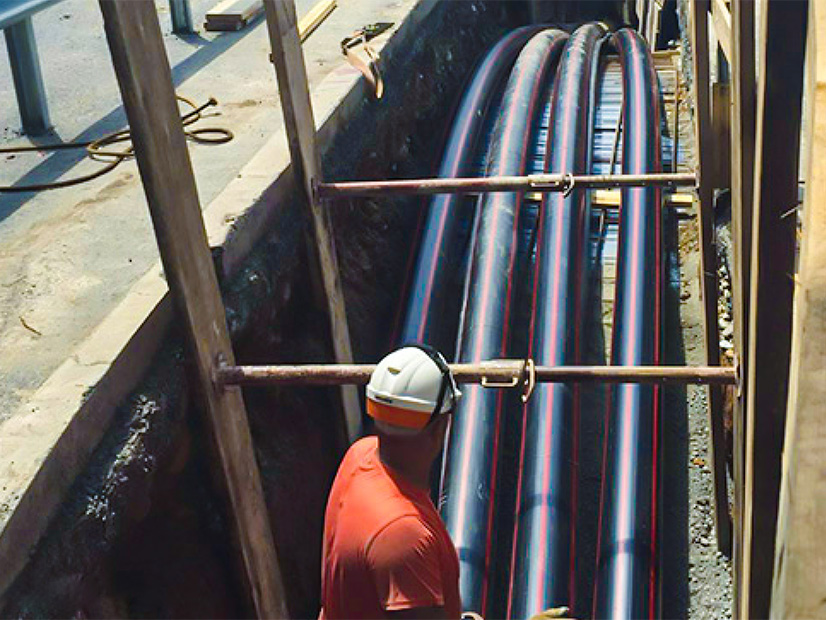FERC last week upheld its prior ruling blocking MISO transmission owners from self-funding network upgrades for merchant HVDC transmission lines.
The commission affirmed in its Friday order a decision issued in the spring that the self-funding option cannot be extended to merchant upgrades because their developers aren’t offered the same range of financing options as transmission owners under certain circumstances (ER22-477-002). (See FERC Blocks MISO Self-fund Rule for Merchant HVDC Line Upgrades.)
FERC rejected arguments from MISO, its transmission owners and ITC Midwest that merchant HVDC developers and generation developers are interchangeable because they both require upgrades to the system for their projects.
The commission again emphasized that MISO doesn’t include an option to build or liquidate damage provisions in interconnection agreements for merchant HVDC developers without injection rights or a precertification from MISO that its system can handle the capacity and energy the line plans to deliver. The grid operator allows merchant HVDC lines to connect to the system without injection rights, but those lines are considered non-firm and the upgrades are classified as necessary upgrades instead of network upgrades.
MISO, TOs and ITC argued that necessary upgrades for HVDC lines are similar to the RTO’s other network upgrades, where the owners have the right to finance the upgrades before the interconnection customers are offered the chance.
“The thrust of MISO and MISO Transmission Owners’ and ITC Midwest’s argument on rehearing is that these two sets of customers are effectively indistinguishable, but neither grapples with how, then, MISO’s proposal to afford options to control risk and certainty during the design and construction process to only one set of customers is just and reasonable and not unduly discriminatory,” FERC wrote.
The commission said MISO’s case for applying initial funding to merchant HVDC lines “does not alter the fact that MHVDC connection customers with necessary upgrades are distinct because, unlike interconnection customers and MHVDC connection customers with network upgrades in MISO, they lack injection rights and are subject to different study requirements.”
Commissioner James Danly again protested the decision, as he did when it first came before FERC. He repeated a dissent that the decision denies “transmission owners’ right to receive a return on and of the capital costs of network upgrades, necessary upgrades and transmission owner system protection facilities.”
Commissioner Mark Christie separately concurred, contending that merchant developers are on equal footing with generation developers in RTOs. He said they should both pay the full “but for” costs of interconnection, including network upgrades.
“When … a generation developer or a merchant transmission line developer pays the full costs of its interconnection, it is the developer incurring a cost of capital, not the transmission owner,” he wrote. “Allowing the transmission owner a profit on someone else’s capital investment would be an unearned windfall. When the transmission owner incurs operations and maintenance costs associated with the upgrade, the transmission owner can seek cost recovery in compliance with applicable utility accounting rules or other acceptable procedures.”
The latest decision on HVDC self-funding is connected to a larger, still-unfolding saga over who has the right to finance line upgrades in MISO.
MISO reinstated TOs’ right to self-fund network upgrades necessary for new generation at the direction of a 2019 FERC order. The decision has been a hot-button issue, spawning three years’ worth of reopened contracts, refunds to interconnection customers, interconnection agreements left unexecuted in protest, and condemnation from FERC Chairman Richard Glick. (See FERC Upholds MISO Self-fund Order, Glick Dissents.)
The D.C. Circuit Court of Appeals in November ruled that FERC did not adequately explain why it recently reinstated transmission owners’ option to self-fund. It remanded the case back to the commission. (See FERC Must Clarify MISO Tx Funding Decision, DC Circuit Finds.)
MISO has revised various interconnection agreements for TOs who wanted to have first crack at network upgrades’ initial funding. (See FERC Accepts Documents in MISO TOs’ Self-fund Selection.)




